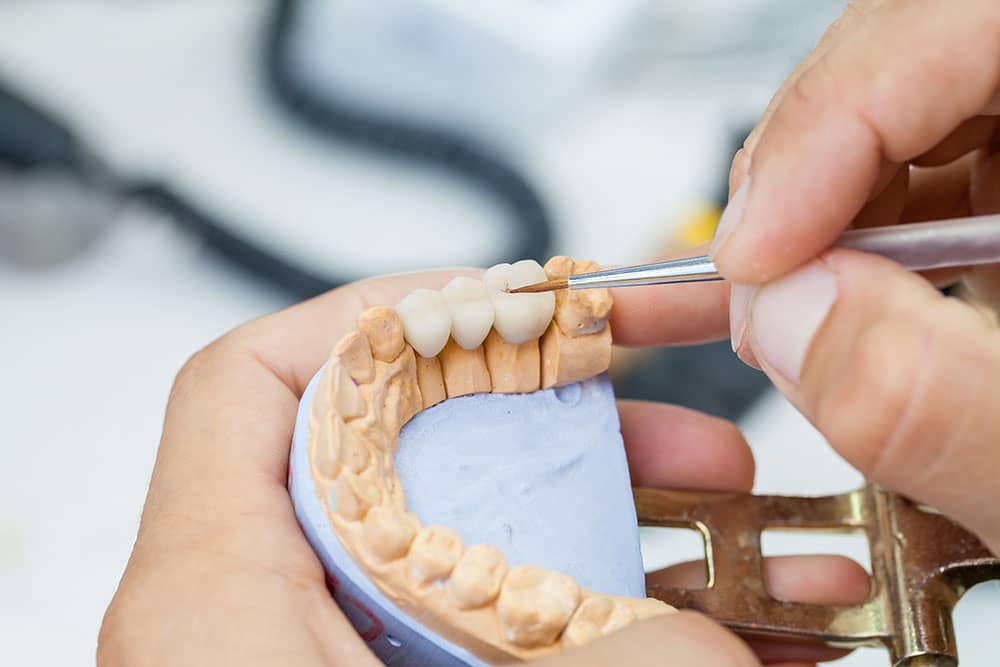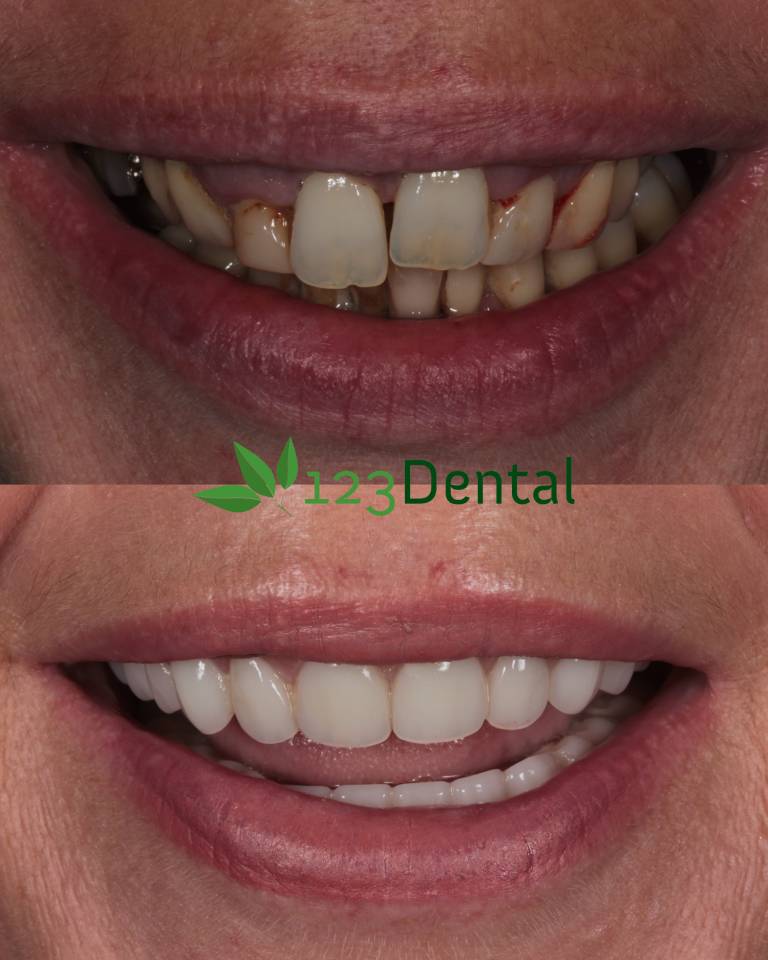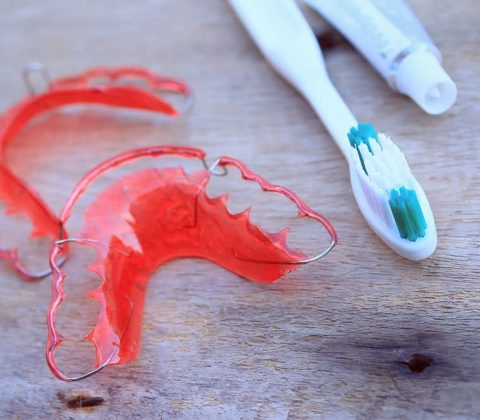When you have damaged or missing teeth, you generally have three options to have an amazing smile again: dentures, bridges, and crowns. Here at 123 Dental, we provide all three solutions to fix your teeth and restore your confidence.
Our dental professionals will assess your case to determine what you need. If you have damaged teeth, such as cracked teeth, a crown may be the ideal choice. In some instances, your tooth is intact but will have to be removed due to advanced cavities. Instead of a crown, we will place a bridge to fill the gap.
If you prefer a denture over a bridge, whether for financial or personal reasons, we can give you dentures instead. We offer both partial and full dentures for suitable clients.
Our crowns, bridges, and dentures are guaranteed to be accurate and well-fitted. It’s time to get rid of that broken smile. Learn more about these dental procedures before you set an appointment with 123 Dental today.
Dental crowns are excellent in restoring the size and shape of teeth, as well as their strength and appearance. The crowns/caps are designed in the form of teeth and are placed over teeth with the aim of covering the teeth.
Importance of Dental Crowns
Dental crowns serve several functions including restoration of broken or worn down teeth, covering misshapen or discoloured teeth, protecting weak teeth, holding bridges in place, repairing teeth that have overly large fillings, and many more.
Types
Usually, permanent crowns are designed using all metal, stainless steel, all ceramic, porcelain infused with metal, porcelain, or all resin. We also offer same day dental crowns (CEREC).
What to Expect at the Dentist
The process of getting a crown comprises two visits to the dentist. At the first visit, the dentist performs a thorough examination of the teeth and also prepares the tooth to receive the crown. In this case, the dentist takes X-rays to assess the roots of the affected tooth, as well as, the condition of the surrounding tissue. For teeth that have extensive decay or are symptomatic, it is likely that a root canal treatment will be done.
Using putty, the dentist then takes an impression of the affected tooth and sends the impression to a dental lab for manufacture. In the meantime, the client will be fitted with a temporary crown as the crown is made. In the second visit, the placement of the permanent crown is done.
Dental Crown Procedure
Possible Complications
In some cases, the crowned tooth may experience sensitivity after the anesthesia used during the fitting procedure begins to wear out. Toothpaste designed for sensitive teeth may alleviate such discomfort. However, if the sensitivity or pain is rampant especially when biting down, it could signal that the crown was not well placed, and one may need to visit the dentist to fix the problem. Sometimes the crown can chip, become loose, develop a dark line next to the gum line, or fall off. The dentist can easily sort such eventualities.
Caring For the Crown
It is vital to ensure that the crown is kept clean as one does their regular brushing. Although the crown is incapable of decay, one should be cautious about decay around the edges of the crown where it fuses with the tooth. Therefore, one should brush before bed and during the day. Well maintained crowns can last for years.
Before & After Treatments
We have managed to create great results for our clients, and here are some of the results. Between each client, results will vary depending on some considerations and dental issues. Please consult your dentist for a personalised plan.
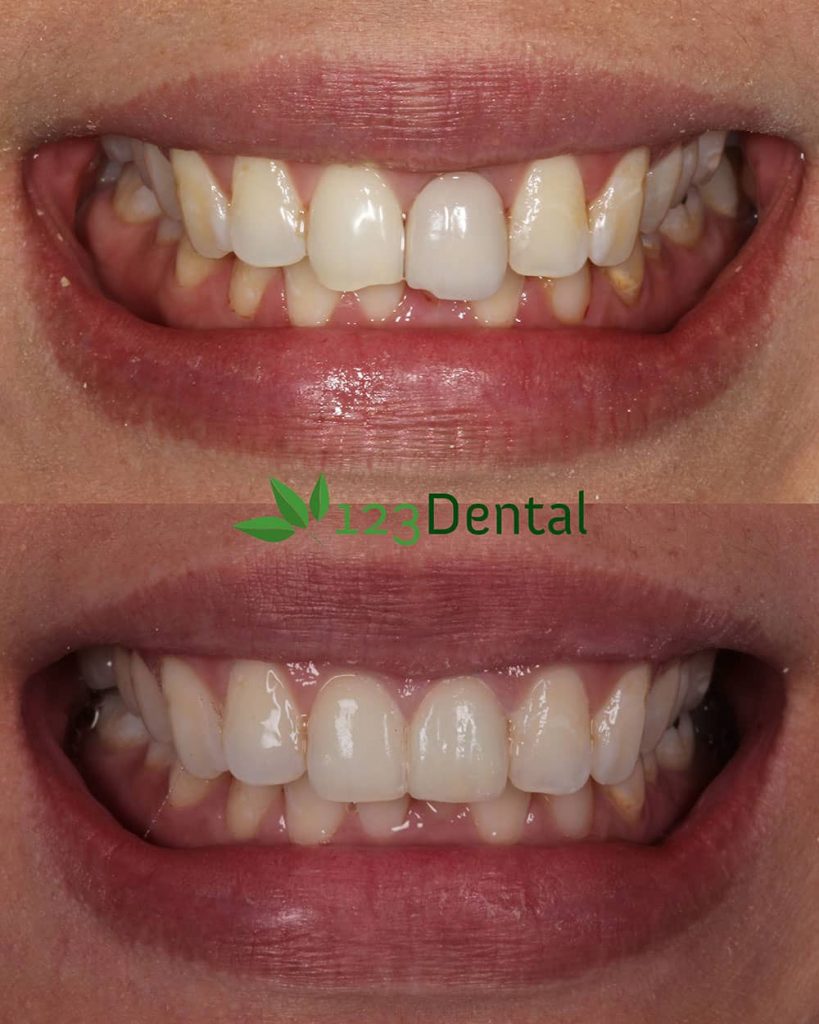
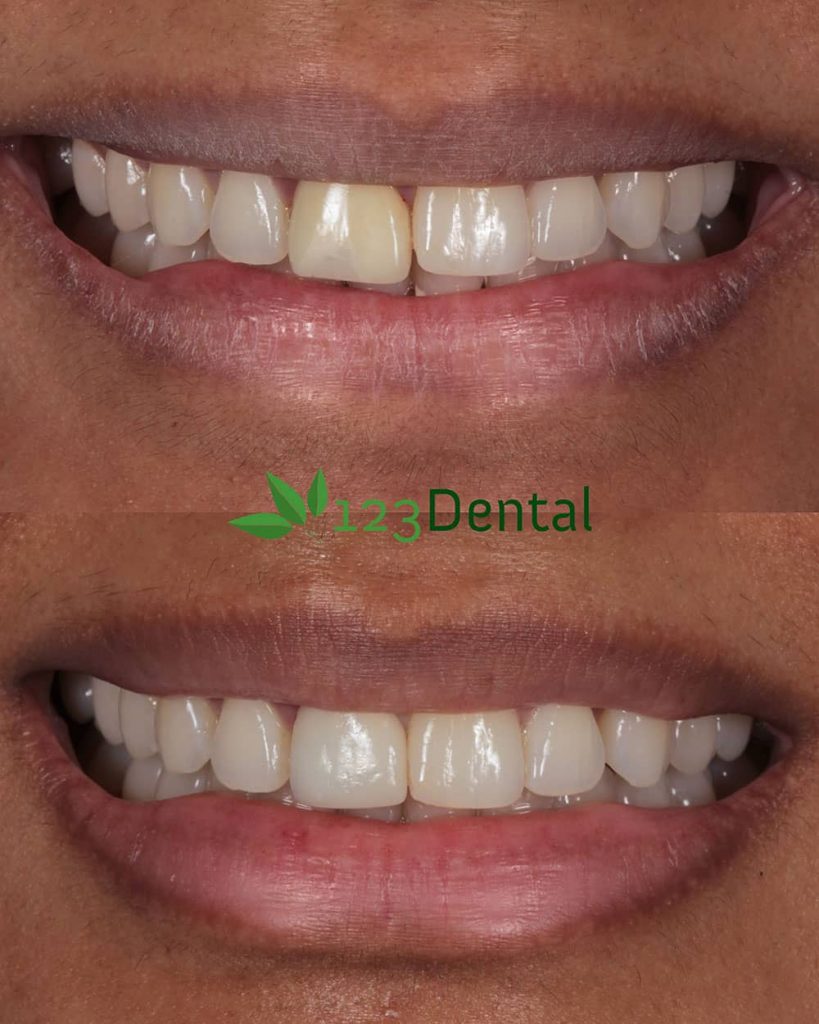
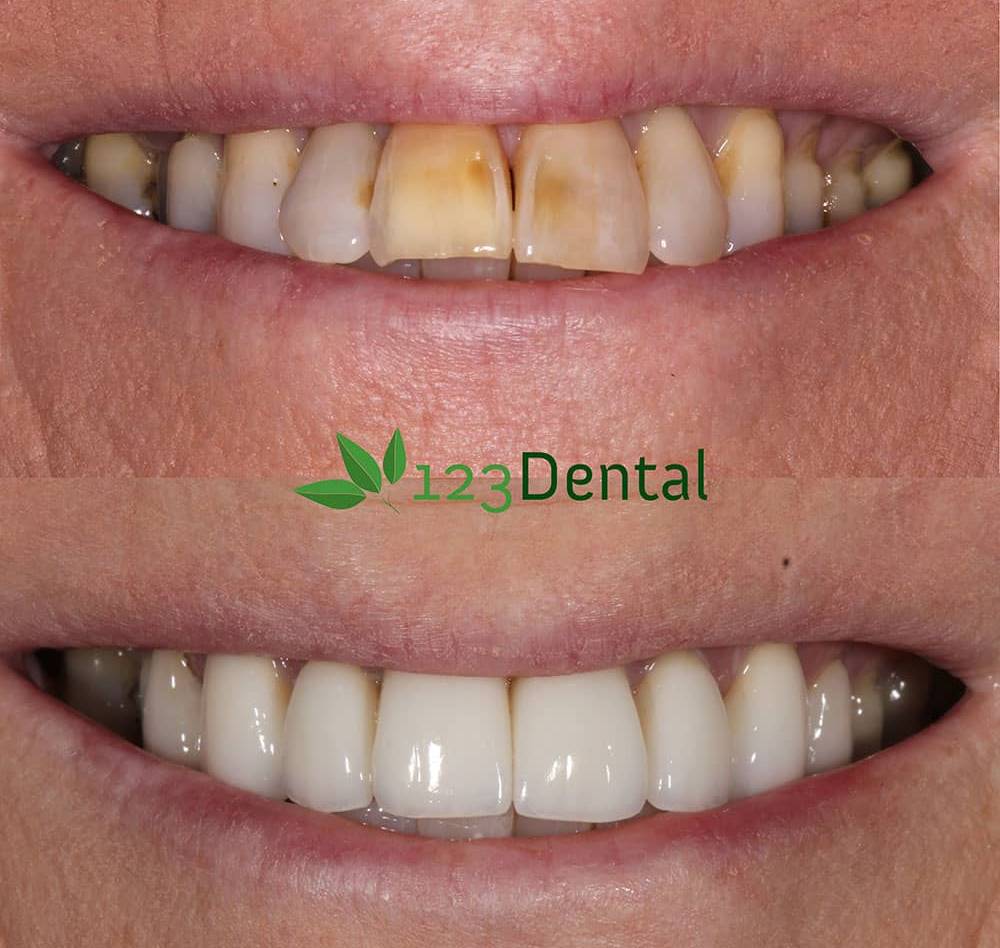
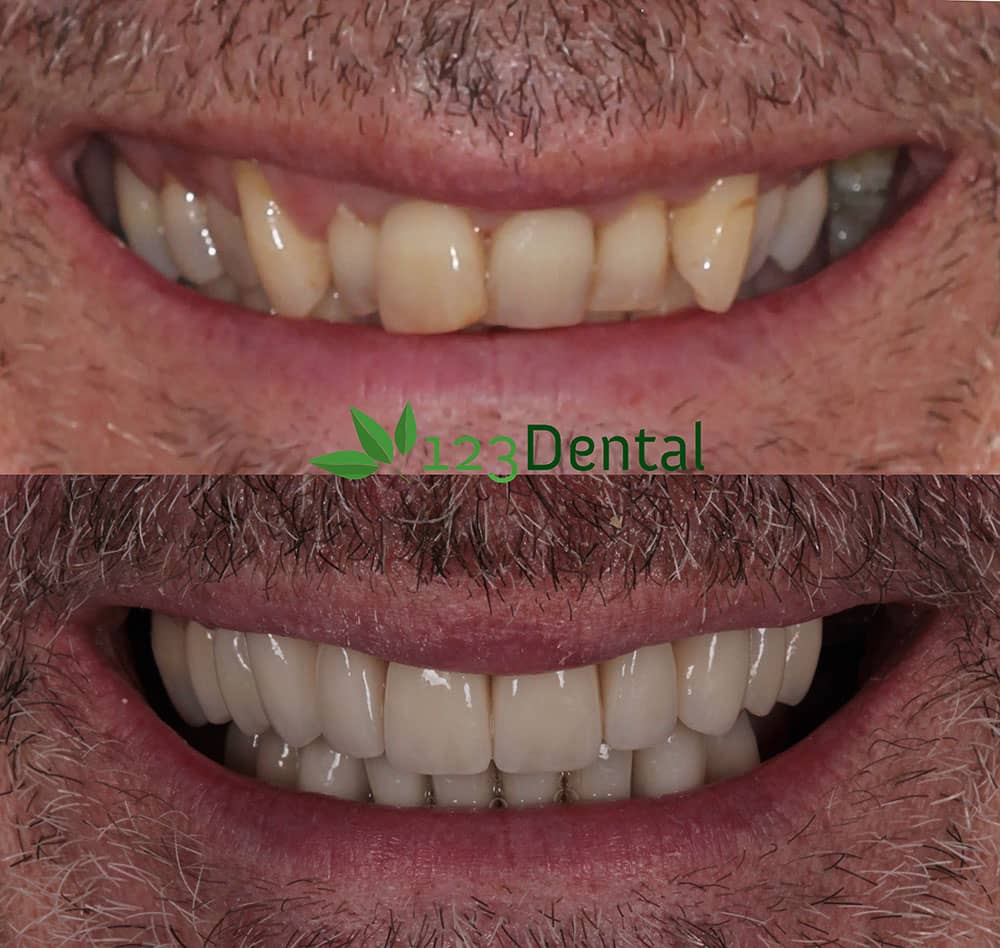
Dental bridges are natural looking fixtures installed with the aim of filling the gap arising from missing teeth and are mainly supported by natural teeth. The design of the bridge consists of two or more crowns meant for the teeth at extreme ends of the gap and false teeth in between. The two natural teeth (receiving the crowns) at either side of the gap are referred to as abutment teeth and the false teeth in between are known as pontics. The pontics are crafted from alloys, porcelain, gold, or a combination of such material.
Types
The three primary types of bridges available include traditional bridges, resin bonded bridges, and Cantilever bridges. For traditional bridges, the most common variant, they have crowns on either side with pontics in between. Cantilever bridges are recommended when the adjacent teeth are available on only one side of the gap. However, they are not common and are discouraged at the back of the mouth where the excessive force on other teeth can damage them. As for resin bonded bridges, they are used majorly for front teeth and may be less costly than fixed bridges. In resin bonded bridges, false teeth are joined to metal bands. The metal bands are subsequently bonded to adjacent teeth.
What to Expect at the Dentist
The first step involves preparation of the adjacent teeth where some of the enamel is removed to accommodate the crown. Subsequently, the dentist takes impressions of the affected teeth and sends them to a lab. A temporary bridge may be given to the patient to protect exposed gums and teeth. In the third visit, the temporary bridge is removed and the permanent one installed.
Recovery and Care
Recovery takes a few weeks, and during that time the client may experience sensitivity. It is advisable to eat soft food that is cut into small pieces. If the patient maintains proper oral hygiene, then the bridge may last from five to fifteen years. Scheduling regular dental visits, as well as cleanings, is imperative.
Dentures are artificial fixtures that act as replacements for missing teeth and their surrounding tissues. They may be made from acrylic or metal. The fixtures allow a person to take them out and put them back into the mouth. Although people take time getting used to dentures and may never feel like they have natural teeth, contemporary denture designs bear a striking resemblance to natural teeth and offer more comfort to the user. In some cases, dentures may be fitted immediately after teeth removal, but in others, dentists advise that the person wait until gums have healed before getting dentures.
Types
The dentures can be classified into either partial or complete dentures. Usually, dentists will offer comprehensive advice on which one suits a person best based on the teeth and affordability. For example, complete dentures are recommended for people whose entire teeth set is missing.
How They are Made
Usually, the dentures are designed in a dental laboratory using impressions from the client’s mouth. Therefore, dentures are custom made for each person. The development of the denture could take several weeks, and within that period, the client requires to go in for several appointments.
How They Work
Partial dentures have a fixed bridge that serves as a replacement for one or more teeth. The bridge is cemented into place allowing the bridge to act as a remedy for filling spaces, as well as, preventing teeth from changing position. For complete dentures, the design has an acrylic material whose colour is akin to that of flesh. The bottom of the lower denture is shaped into the form of a horseshoe to accommodate the tongue. The top denture has a base that covers the roof of the mouth (palate).
Getting Accustomed to Dentures
New dentures may feel strange and uncomfortable in the first couple of weeks to months. At that time, the muscles of the tongue and cheeks learn to adjust and keep them in place. Eating food and speaking might seem challenging, and most people reiterate that they experience a bulky and loose sensation in the mouth. Also, the person may experience excessive saliva, minor irritation, and feel like the tongue’s movement is constricted, but such symptoms dissipate with time. However, it is imperative to see a dentist if one experiences excessive irritation.
Longevity
Dentures require to be relined, rebased, or overhauled due to normal wear. As people age, the mouth changes and such changes may cause the dentures to become loose. Chewing thus becomes difficult, and the gums become irritated. Therefore, it is recommended that a person visit a dentist at least annually to ascertain if dentures need to be adjusted.
Caring for your Dentures
Dentists recommend that a person brushes their dentures every day as it helps to remove food deposits and plaque. The rule of thumb is to brush, soak, and then brush again. Soaking aids with the removal of food debris and regular brushing prevents the occurrence of stains. One should ensure that they do not brush too aggressively as it can create grooves in the surface of the denture.
In regards to soaking, dentures should not be soaked in hot water as they can warp and lose shape. The recommended way to soak them is to use a cleanser soaking solution or plain water. Effervescent cleaners also help to eliminate stains. Further, the dentures should not be left to dry out. It is also essential to use a toothbrush with soft bristles to clean the mouth after removing dentures.
- Crowns
-
Dental crowns are excellent in restoring the size and shape of teeth, as well as their strength and appearance. The crowns/caps are designed in the form of teeth and are placed over teeth with the aim of covering the teeth.
Importance of Dental Crowns
Dental crowns serve several functions including restoration of broken or worn down teeth, covering misshapen or discoloured teeth, protecting weak teeth, holding bridges in place, repairing teeth that have overly large fillings, and many more.
Types
Usually, permanent crowns are designed using all metal, stainless steel, all ceramic, porcelain infused with metal, porcelain, or all resin. We also offer same day dental crowns (CEREC).
What to Expect at the Dentist
The process of getting a crown comprises two visits to the dentist. At the first visit, the dentist performs a thorough examination of the teeth and also prepares the tooth to receive the crown. In this case, the dentist takes X-rays to assess the roots of the affected tooth, as well as, the condition of the surrounding tissue. For teeth that have extensive decay or are symptomatic, it is likely that a root canal treatment will be done.
Using putty, the dentist then takes an impression of the affected tooth and sends the impression to a dental lab for manufacture. In the meantime, the client will be fitted with a temporary crown as the crown is made. In the second visit, the placement of the permanent crown is done.
Dental Crown Procedure
Possible Complications
In some cases, the crowned tooth may experience sensitivity after the anesthesia used during the fitting procedure begins to wear out. Toothpaste designed for sensitive teeth may alleviate such discomfort. However, if the sensitivity or pain is rampant especially when biting down, it could signal that the crown was not well placed, and one may need to visit the dentist to fix the problem. Sometimes the crown can chip, become loose, develop a dark line next to the gum line, or fall off. The dentist can easily sort such eventualities.
Caring For the Crown
It is vital to ensure that the crown is kept clean as one does their regular brushing. Although the crown is incapable of decay, one should be cautious about decay around the edges of the crown where it fuses with the tooth. Therefore, one should brush before bed and during the day. Well maintained crowns can last for years.
Before & After Treatments
We have managed to create great results for our clients, and here are some of the results. Between each client, results will vary depending on some considerations and dental issues. Please consult your dentist for a personalised plan.
- Bridges
-
Dental bridges are natural looking fixtures installed with the aim of filling the gap arising from missing teeth and are mainly supported by natural teeth. The design of the bridge consists of two or more crowns meant for the teeth at extreme ends of the gap and false teeth in between. The two natural teeth (receiving the crowns) at either side of the gap are referred to as abutment teeth and the false teeth in between are known as pontics. The pontics are crafted from alloys, porcelain, gold, or a combination of such material.
Types
The three primary types of bridges available include traditional bridges, resin bonded bridges, and Cantilever bridges. For traditional bridges, the most common variant, they have crowns on either side with pontics in between. Cantilever bridges are recommended when the adjacent teeth are available on only one side of the gap. However, they are not common and are discouraged at the back of the mouth where the excessive force on other teeth can damage them. As for resin bonded bridges, they are used majorly for front teeth and may be less costly than fixed bridges. In resin bonded bridges, false teeth are joined to metal bands. The metal bands are subsequently bonded to adjacent teeth.
What to Expect at the Dentist
The first step involves preparation of the adjacent teeth where some of the enamel is removed to accommodate the crown. Subsequently, the dentist takes impressions of the affected teeth and sends them to a lab. A temporary bridge may be given to the patient to protect exposed gums and teeth. In the third visit, the temporary bridge is removed and the permanent one installed.
Recovery and Care
Recovery takes a few weeks, and during that time the client may experience sensitivity. It is advisable to eat soft food that is cut into small pieces. If the patient maintains proper oral hygiene, then the bridge may last from five to fifteen years. Scheduling regular dental visits, as well as cleanings, is imperative.
- Dentures
-
Dentures are artificial fixtures that act as replacements for missing teeth and their surrounding tissues. They may be made from acrylic or metal. The fixtures allow a person to take them out and put them back into the mouth. Although people take time getting used to dentures and may never feel like they have natural teeth, contemporary denture designs bear a striking resemblance to natural teeth and offer more comfort to the user. In some cases, dentures may be fitted immediately after teeth removal, but in others, dentists advise that the person wait until gums have healed before getting dentures.
Types
The dentures can be classified into either partial or complete dentures. Usually, dentists will offer comprehensive advice on which one suits a person best based on the teeth and affordability. For example, complete dentures are recommended for people whose entire teeth set is missing.
How They are Made
Usually, the dentures are designed in a dental laboratory using impressions from the client’s mouth. Therefore, dentures are custom made for each person. The development of the denture could take several weeks, and within that period, the client requires to go in for several appointments.
How They Work
Partial dentures have a fixed bridge that serves as a replacement for one or more teeth. The bridge is cemented into place allowing the bridge to act as a remedy for filling spaces, as well as, preventing teeth from changing position. For complete dentures, the design has an acrylic material whose colour is akin to that of flesh. The bottom of the lower denture is shaped into the form of a horseshoe to accommodate the tongue. The top denture has a base that covers the roof of the mouth (palate).
Getting Accustomed to Dentures
New dentures may feel strange and uncomfortable in the first couple of weeks to months. At that time, the muscles of the tongue and cheeks learn to adjust and keep them in place. Eating food and speaking might seem challenging, and most people reiterate that they experience a bulky and loose sensation in the mouth. Also, the person may experience excessive saliva, minor irritation, and feel like the tongue’s movement is constricted, but such symptoms dissipate with time. However, it is imperative to see a dentist if one experiences excessive irritation.
Longevity
Dentures require to be relined, rebased, or overhauled due to normal wear. As people age, the mouth changes and such changes may cause the dentures to become loose. Chewing thus becomes difficult, and the gums become irritated. Therefore, it is recommended that a person visit a dentist at least annually to ascertain if dentures need to be adjusted.
Caring for your Dentures
Dentists recommend that a person brushes their dentures every day as it helps to remove food deposits and plaque. The rule of thumb is to brush, soak, and then brush again. Soaking aids with the removal of food debris and regular brushing prevents the occurrence of stains. One should ensure that they do not brush too aggressively as it can create grooves in the surface of the denture.
In regards to soaking, dentures should not be soaked in hot water as they can warp and lose shape. The recommended way to soak them is to use a cleanser soaking solution or plain water. Effervescent cleaners also help to eliminate stains. Further, the dentures should not be left to dry out. It is also essential to use a toothbrush with soft bristles to clean the mouth after removing dentures.
Dental Crown, Denture & Bridge Blogs
FAQ’s
Is a Crown or Bridge Better for Me?
Can People Tell If I Have a Bridge, Crown, or Denture?
How Long Do Dental Crowns, Bridges, and Dentures Last?
Why Should I Bother Fixing Missing Teeth?
What are the Alternatives to a Partial Denture?
Can I Have a Denture or Bridge Right After a Teeth Extraction Procedure?
Will It Be Difficult to Eat with a Crown, Bridge, or Denture?
Bridges and dentures – and even crowns – help you bite better. That’s because you do not have to worry about your missing or damaged teeth. You should have no problem eating the foods you usually eat. However, it is best to avoid crunchy, chewy, and hard foods if you just had the dental procedure. Wait for a couple of weeks before you eat what you want. You will be advised to consume soft foods and smaller bits so you can chew without issues.
Do you offer same day crowns?
Yes, at 123Dental we offer same day dental crowns. For more information click here.


